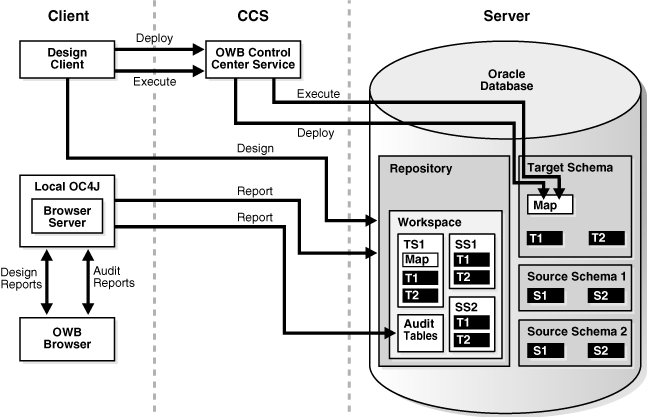| Oracle® Warehouse Builder Installation and Administration Guide 11g Release 2 (11.2) for Windows and Linux Part Number E10579-01 |
|
|
View PDF |
| Oracle® Warehouse Builder Installation and Administration Guide 11g Release 2 (11.2) for Windows and Linux Part Number E10579-01 |
|
|
View PDF |
This section discusses the installation and configuration architecture of Oracle Warehouse Builder.
This section includes the following topics:
Depending on the business needs of your organization, you may be implementing different types of Oracle Warehouse Builder installations, as follows:
The primary installation of Oracle Warehouse Builder, which includes the installation and configuration of the main design repository.
Optional installations on client computers where developers and administrators run the Oracle Warehouse Builder client software, but that do not contain a repository.
Optional installations on hosts that run the Control Center Agent service, but do not contain a repository.
Optional installations on database server hosts, where ETL jobs execute and where the repository stores only run-time data.
The following section provides an overview of examples of various common topologies. The software installation tasks are described in Chapter 2, "Installing Oracle Warehouse Builder on the Server", while configuration for Windows and Linux platforms are covered in Chapter 3, "Configuring Oracle Warehouse Builder for Windows" and Chapter 4, "Configuring Oracle Warehouse Builder for Linux", respectively.
Primary Oracle Warehouse Builder components include the OWB Client (it includes the Design Center and the Control Center Manager), the OWB Browser, the Control Center Service, the Control Center Agent, and the Repository.
Depending on your business needs, there are many possible installation configurations. The five most common topologies are as follows:
Note that in any of these topologies, it is common to have multiple design clients. For example, each OWB developer or administrator usually has an installed design client.
When everything is running on the same computer, the database home for Oracle Database 11g Release 2 contains all the components needed to run OWB, as illustrated in Figure 1-1.
Figure 1-1 Single Computer Topology for Oracle Database 11g Release 2

If separate computers are being used to run the client and to host the repository, then all computers need to have the OWB software installed, as illustrated in Figure 1-2. For the database server installation, Oracle Database 11g Release 2 includes the necessary components. For the client, you must install the OWB software from the standalone install image.
Figure 1-2 Two Computer Topology; Separate Client and Database Server Installations

If a database on a separate computer is being used to run mappings designed on another database, then all computers need to have the OWB software installed, as illustrated in Figure 1-3. For the database servers, the installation for Oracle Database 11g Release 2 includes the necessary components. For the client, you must install the OWB software from the standalone install image.
You must prepare the OWB repository on both database server computers. One acts as the design repository (Server1). The server where mappings execute (Server2) has its own repository, which it uses as a run-time repository. The Control Center Service on the execution database server deploys and executes the code.
If the client, the Control Center Service, and the repository run on different computers, then all these computers need to have the OWB software installed, as illustrated in Figure 1-4. For the database server, the installation for Oracle Database 11g Release 2 includes the necessary components. For the client, you must install the OWB software from the standalone install image. For the Control Center Service, you can use either install. However, Oracle recommends that you use the standalone image because it installs only the components that OWB requires.
Figure 1-4 Separate Client, Control Service Center, and Database Server Topology

If separate computers are used to run the client, the Control Center Agent service, and the repository, then all computers used to deploy or execute OWB code must have installed OWB software, as illustrated in Figure 1-5. For the database server, the installation for Oracle Database 11g Release 2 includes the necessary components. For the client, you must install the OWB software from the standalone install image. For the Control Center Agent service, you can use either install. However, because the standalone image only installs the OWB-required components, it is the recommended option.
In some deployments, a Control Center Service is required on a host that does not have an Oracle Database installed. For example, if you use code template-based ETL mappings where part of the mapping executes on a non-Oracle database, you can run a Control Center Agent on that non-Oracle database host. In such a case, you can install the OWB software on the non-Oracle database host.
Also note that:
On the non-Oracle database host, the only component of the OWB software that is used is the Control Center Agent. The rest of the software is present but not used.
The CCA may be co-located with the Client or Server1, in which case no additional install would be necessary.
In this example, the Map1 has three execution units (a, b, c). The first two are Load Code Templates (LCTs) and the other one is an Oracle Target Code Template.